 |
|
||
This article is devoted to an extinct chordophone that has hitherto received little critical attention. Curiously enough, while there is much written evidence of this instrument’s widespread presence throughout 12th and 13th century Christian Europe, the instrument’s name in medieval times has remained a mystery. We refer to it using circumlocutions that evoke the characteristic shape of its body: “viele en huit” in French, “achtformfidel” in German, “fidula en ocho” in Spanish. In reference to the “da gamba” way of holding the instrument, English speakers have opted for the term “medieval viol”. In the first part of this article, we will describe the instrument and its playing technique from an organological point of view drawing comparisons with the medieval fiddle, then we will attempt to specify its musical function, before presenting arguments in favour of the medieval use of the term “giga” (in Latin, Spanish, Italian and Occitan,) “geige” (in German) “gige” (in German dialect) to designate the instrument.
The Organological point of view.
Thorough, pluridisciplinary work was carried out on the Gate of the Glory at Santiago de Compostela between 1988 and 1994 to reconstruct medieval stringed instruments. This work has improved our knowledge of certain early instruments, including the oval fiddle[1]. On the arches of this famous edifice, which was completed in 1188, Master Matteo’s workers sculpted 21 instruments including eight oval fiddles and four “figure of eight shaped fiddles". The fact that the instruments are shown in various positions, makes detailed and exhaustive observation possible.
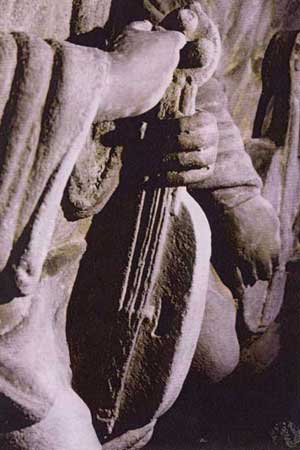 |
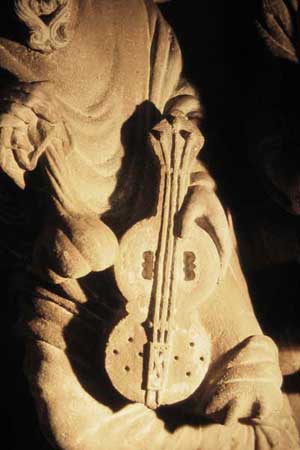 |
|
Plate1: An "oval fiddle" on the gate of the glory at Santiago Compostela cathedral (1188).
|
Plate 2: "Eight shaped fiddle" or giga on the gate of the glory at Santiago Compostela cathedral.
|
The following comparative chart sums up the characteristics of each instrument:
|
Oval Fiddle[2] |
Eight Shaped Fiddle |
|
|
Size |
Small to medium |
Medium to large |
|
Body |
oval |
Figure of « 8 » |
|
Neck |
Ovoid or pentagonal cross-section |
Square cross-section |
|
Head or pegbox |
Flat pegbox equal in depth to the ribs with hollow moulded sides, hollowed out in the rear. |
Flat pegbox thinner than the ribs |
|
Ribs |
Hollow moulded sides |
Hollow moulded sides |
|
Back |
Convex |
Flat |
|
Belly |
Convex |
Flat |
|
Sound holes |
Two symmetrical sound holes |
Two symmetrical sound holes with, frequently, additional small circular holes |
|
Pegs |
5, adjusted from the front of the pegbox |
3, adjusted from the back of the pegbox |
|
Nut |
No nut or nut made of a thin gut string, as on the later frets on viols and lute |
Strong and high nut made of wood or bone. |
|
Fingerboard |
Flat fingerboard extending a small distance over the belly. |
No fingerboard. |
|
Bridge |
Thin bridge with triangular cross-section. |
Strong bridge with rectangular cross-section. |
|
Strings |
5 strings : generally 2 paired strings over the fingerboard and 1 offset drone. |
3 strings high over the neck. |
|
String arrangement |
The 2 paired strings pass through holes in the front of the head and meet the pegs in the pegbox. The drone goes directly to its peg or penetrates the pegbox on its side. |
The 3 strings, pass over the nut and the front side of the pegbox to meet directly up with the pegs. |
|
Tail piece |
Trapezoïdal fixed by a string to the skeg protruding from the bottom part of the ribs. |
Trapezoïdal fixed by a string to the skeg protruding from the bottom part of the ribs. |
|
Playing position |
« da braccio » |
« da gamba » |
Features common to both instruments.
According to the relevant classification, both instruments belong to the lute family with bowed strings. The hollowed-out ribs suggest that these instruments have the same construction process: body, neck and pegbox are sawn out of a single piece of wood whose depth is equal to the height of the ribs. Back and belly are glued on later. Both instruments have a flat pegbox, a bridge and a tailpiece fastened by a string to the skeg protruding from the lower part of the ribs.
Differences.
The most obvious difference concerns the general outline of the body. The two circles joined together form such a characteristic shape that the instrument stood out and has been known, since the nineteenth century, as the "figure of eight shaped fiddle". Unlike the oval fiddle, the eight shaped fiddle always has an entirely flat back and belly. Its neck presents a thick, square cross-section and has no fingerboard. Both the nut and the bridge have greater volume and height. The pegbox is not hollowed out through the back and the strings meet the pegs directly at the front[3]. The pegs are manipulated from the back, while those of the medieval fiddle are adjusted from the front. The medieval fiddle has five strings, two paired strings pass through the holes on the front of the head to join the pegs inside the hollowed out pegbox. The drone[4] goes directly to the peg or goes into the side of the pegbox. It is played “da braccio” whereas the medieval viol, played “da gamba”, has three single strings. (plate 3 and 4)
 |
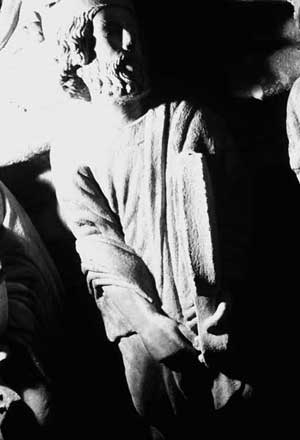 |
|
Plate 3: Detail of the neck of the giga at Santiago Compostela. |
Plate 4: Neck and ribs of an "oval fiddle" on the gate of the glory at Santiago Compostela.
|
Commentary.
It is important to note that the observations on the Gate of the Glory are, for the most part, corroborated by documentary evidence. The two instruments are undeniably distinct and easily recognisable. Amongst other specifications of the "figure of eight shaped fiddle", the systematic absence of fingerboard is vital to our reasoning. This essential element, only rarely omitted in representations of the medieval fiddle is never present in representations of our eight shaped instrument. Moreover, we have noticed that both the bridge and the nut which are discreet on the medieval fiddle are extremely noticeable on our instrument and give the impression that the strings are far from the neck. This observation, which is particularly obvious at Santiago[5] and on Angers cathedral (plate 5) is borne out by the western and southern entrances at Chartres. (plate 6 and 7)
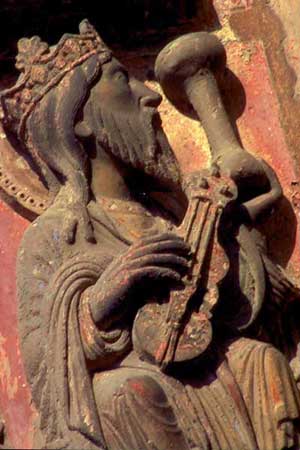 |
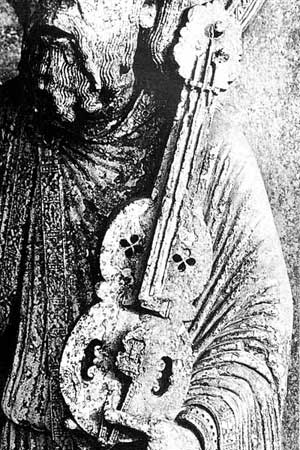 |
|
Plate 5: Giga on the west gate at Angers cathedral. |
Plate 6: Giga on on the west gate at Chartres cathedral (1142-1150).
|
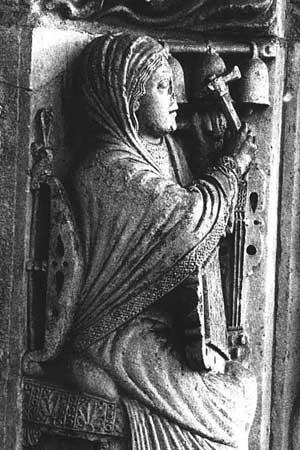 |
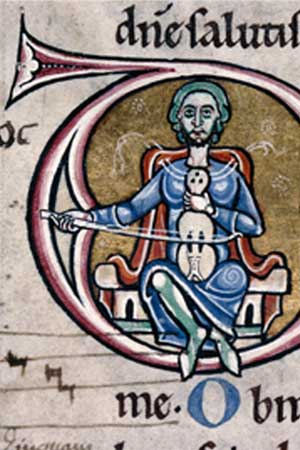 |
|
Plate 7: Giga on on the south gate at Chartres cathedral (1198-1209). |
Plate 8: Giga: ornate initial from the psalm 38 in a Bible originated from Montiéramey abbaye.
Troyes, Mun. Libr. Ms. 28-2 f°23v°. (1150-1175). |
Relationship to the organistrum.
Another medieval chordophone , the organistrum[6], appears to be related to the giga. Firstly, it is the only other instrument in a figure of eight shape. Secondly, the two instruments are contemporary. The first occurrence of the word organistrum dates back to 1100[7], while the first depiction of the "figure of eight shaped fiddle" can be traced back to 1109[8]. Much documentary evidence of both instruments exists from the middle of the twelfth century whereas they died out simultaneously at the end of the following century. They frequently appear in the same iconographical context[9] and both have three strings.
As we have not time enough to go into detail about the history and structure of this instrument with a perpetual bow, ancestor of the hurdy-gurdy, invented in order to teach the first forms of written polyphony, we would simply like to point out that it is the first stringed instrument with a keyboard. It takes two musicians to play the instrument : one turns the handle that pulls the bow (which is in constant contact with the string, that is the wheel), the other plays on the keyboard. This keyboard, divided according to the principles attributed to Pythagorus, functions by shortening the vibrating length of the strings. By pulling on one of the keys of the keyboard the musician brings the bridge-like tangent into contact with the strings. So, when the roisined wheel rubs against the strings their vibrating length is reduced and the pitch becomes higher. This means of shortening the vibrating length is quite different from the one used for violins or guitars. In the case of these necked instruments, the finger pinches the string against the flat surface of the fingerboard, unlike the tangent of the organistrum which works without any flat surface. In this case it is simply the lateral contact with the string which changes the note.
Playing technique.
This playing technique on bowed strings is not entirely unknown to us, since even today it can be observed on all bowed instruments from the North Africa to the Middle East. Two techniques continue to coexist: either the joint of the first phalanx touches the string directly, as is the case for various forms of the rabâb and far-eastern viols[10], or the back of the nail alters the vibrating length of the string as for the Greek lyre or the Indian sarangi.
These techniques have more or less disappeared in the west, but this does not mean that they were never practised in the past[11]. It should not be forgotten that the bow came to us from Central Asia where it was the only playing technique known.
In Christian Europe the presence of offset drones on the medieval fiddle (as well as on the later lira da braccio) played directly with the thumb, appears to be surviving examples of this primitive eastern technique. If we observe the respective profiles and cross-sections of the necks of the fiddle and the giga, we will see that the former already boasts much of the subtlety of 16th century violins and is ergonomically well-adapted for prehension, whilst the “figure of eight fiddle”, which is thick and hefty is better adapted to the eastern technique. In this case the instrument is played on the lap and only the thumb is placed on the lateral side of the neck. (figs. 3 and 5)
To sum up :
1. The common Eastern origin of the bow, the playing technique (where fingerboards are not used) and the “da gamba position”,
2. The absence of fingerboard on the "figure of eight fiddle",
3. The marked protuberance of both the nut and bridge,
4. The greater distance thus created between the strings and the neck,
5. The square cross-section of the neck,
6. The cultural, musical and organological links to the organistrum,
7. The presence of offset drones on the medieval fiddle and lira da braccio,
8. And finally its survival in Europe, [12]
are all reasons to assume that this direct fingering technique which excludes the use of the fingerboard was used on the giga.
Tuning the "figure of eight fiddle"
Unlike the medieval fiddle whose tuning was precisely defined by Jerome of Moravia we know nothing of the way a giga was tuned. However, we do know the tuning of the organistrum. If we accept the apparent link between the latter instrument and the three-stringed fiddle (tricordum giga)[13] , tuning would be defined by the first three consonances[14]. In the case of these two instruments we do not know the order of the strings which results in the succession fifth-fourth-octave
Musical Function
Just as the shape, the way the instrument was held and the playing technique of the "eight shaped instrument" contrasted markedly with those of the medieval fiddle, so its musical function was also very different. The organistrum which originated in Benedictine abbeys[15] is clearly associated with the religious practice of song. The technical complexity of this instrument (which is both difficult to make and difficult to regulate) may explain why it needed to be simplified. The giga resembles an organistrum without its mechanical equipment: the handle, axle, wheel and keyboard. It is hardly a coincidence if this instrument devoid of mechanical artifices made its first appearance in 1109 in the Cistercian[16] community rather than among the Benedictines. However, although the giga took on psalmody as the musical, pedagogical and religious function that was elsewhere entrusted to the scholarly organistrum, it was ill–adapted to profane music, over which the fiddle had reigned supreme for many centuries. The left handed eastern technique used on the gut strings[17] was incompatible with rapid and complex melodic lines[18]. Wherever it is still in use, its role is limited to a supporting one, to guide the singers (the arabo-andalusian rabab), or as a back-up to monophonic chants or narratives (spiked fiddles)[19].The very principle of the Eastern technique limits the fingering to only one string at a time, the other strings being used as a drone to underline the text or to give rhythm to a melody.
Moreover, the “da gamba” position means that the musician must remain seated, thus corresponding to our idea of noble, learned and dignified musicianship[20] (plate 8), it is hardly adapted to making people dance and the gaiety of pagan feasts.
Although all stringed instruments are to be found in the hands of devils or grotesque animals in a context of condemnation, at some time or another in medieval iconography, two instruments were never caught out in such a position : the organistrum and the "figure of eight fiddle". Fiddle players and giga players had, in any case, neither the same function, nor the same status as can be deduced from the ledgers of the kings of England, who did not give equal treatment to vidulatores and gigatores.[21]
The Giga in manuscripts
Gauthier de Coincy, who became archprior at St. Médard de Soissons in 1233, was a cultivated nobleman. He frequented both the courts and the intellectual circles of his time and specifies that the clergy particularly appreciated the sound of the fiddle, the harp, the psaltery, the organ and the giga[22], while his contemporary Jean de Garlande placed the giga among the instruments to be found in wealthy Parisian households[23] and described it as an instrument which imitated the organum.[24] The idea that this instrument belonged in rich and cultivated circles is backed up by a German narrative text Der Busant (The Falcon) which describes a giga equipped with silk strings “ as though it were to be played by a prince, with its ornate body, its neck encrusted with gold, precious stones and noble ivory and the case seemed to be made of fine silk embroidered with magnificent pictures.”[25] We also know that gigatores played regularly at the court of the English Kings between 1274 and 1331.[26]
The problem of naming the instrument
And so we come to the tricky problem of the designation of our instrument. In order to clarify a certain number of points we must first eliminate the inaccurate, though deeply rooted idea surrounding the existence of the pear-shaped medieval rebec. We have shown elsewhere that no such medieval rebec existed.[27]
We should bear in mind that the word rubeba (a Parisian Latinisation of the Arabo-Andalusian name “rabab”) first appeared in France in the writings of Jerome of Moravia in 1280. This word had recently appeared in Spain[28] and gradually made its way into our Western instrumentarium. The term altered and at the beginning of the Renaissance became “rebec”, there is no evidence of the use of this term before 1379[29]. These chronological facts did not prevent our predecessors from creating confusion by retrospectively naming all pear-shaped medieval fiddles : rebecs. However these, sawn-out instruments whose ribs are always clearly defined and have a glued back and flat pegbox, bear all the aforementioned characteristics of a medieval fiddle. In the Middle Ages the degree of differentiation between the body and the neck of an instrument did not in any way alter its definition.
Be it pear-shaped or oval, a fiddle is still a fiddle, and the retrospective distinction between two different types of instrument, the fiddle and the rebec is entirely devoid of any documentary or organological basis before the Arabic contributions of the late thirteenth century : the rounded back and sickle-shaped head with transversal pegs. The assimilation in the west of these new elements did not come into effect before the very end of the fourteenth century.
From the beginning of the eleventh to the end of the thirteenth century, judging by documentary evidence, only two chordophones of the bowed lute family coexisted. One, fitted with a fingerboard and five strings[30] was played “da braccio”, its repertoire was, more often than not, profane, though erudite: the fiddle; the other, equipped with three strings played with the Eastern technique and “da gamba” was largely confined to worthy contexts where culture and Christianity were “de rigueur”: the giga. The fiddle possessed such a musical and expressive potential that it was to adapt perfectly and withstood the successive aesthetic upheavals between the eleventh and sixteenth century. The giga, a more austere instrument, would disappear from south-western European countries at the end of the thirteenth century, pushed aside, along with the art of Léonin and Pérotin by the “Ars Nova”. It survived longer in Anglo-Saxon countries which remained receptive to polyphonic forms close to those of the ancient organum[31]. The “figure of eight fiddle ” was only to have known two centuries of glory, though during the twelfth and thirteenth centuries the names of bowed instruments were few and far between.
Given that the words rubèba and rebec are anachronisms and that the Latin terms lyra and cythara evoked Antiquity (which generally came down to a pseudo-erudite convention of latin polysemic terms), we are left with only two terms : fiddle and giga[32].
Let us now examine the meaning attributed to the word giga.
Since the first research into early instruments began in the nineteenth century the word giga has remained a source of puzzlement. We will examine all of the complex, though unsatisfying justifications which have lead to the following consensus, tirelessly repeated since the days of Fétis (1865) and Grillet (1901) : “the giga is a rebec, only smaller”. This cliché originated in the prints of the Germanic treaties of Virdung (1511), Agricola (1528-1585) and then Praetorius (1624) where rebecs are glossed as kleinen Geigen.
The word giga whose Germanic origin remains debatable, appeared simultaneously in the middle of the twelfth century in France, Germany and England. It rapidly spread to other vernacular European languages. However, in the fourteenth century it disappeared from Latin languages, whilst holding its own in Germanic languages under the generic term of bowed-instruments. This definition had already become so common in the sixteenth century that when the works of Virdung, Agricola and Praetorius were published these authors used the term “geige” to define viols as well as violins, pochettes and rebecs. Today, the word “geige” is still polysemic in Germanic languages. Curiously, since the nineteenth century the word giga, which should be used to designate an instrument contemporary to the manuscipts in which it is mentioned, has been used to refer to a smaller and ill-defined variant of the rebec. However, we have already established that the latter, with its round back and its sickle-shaped pegbox only appeared at the very end of the fourteenth century. This anachronism needs to be reconsidered therefore and we should accept documentary evidence from the twelfth and thirteenth centuries which provide iconographical proof of the existence of only two distinct types of bowed lutes. Manuscripts from the same period provide only two words to designate them……fiddle and giga.
Michel Hugho discovered the word braci a hybrid term composed of the Latin brachium (arm) and the vernacular German “bratsche” in a tenth century manuscript the Musica Enchiriadis of Valenciennes[33]. This term had been crossed out and replaced by “cithara” probably considered more correct by a learned reader. Even today “bratsche”[34] is a Central European term for all instruments that are held “da braccio”. The parallel is interesting and we may wonder at which point the terms “braci” and “giga” came to define the opposition still in force today, between “da braccio” and “da gamba”.
One should not deduce from this brief demonstration any necessary link between name and form. According to medieval logic a musical instrument is defined neither by the design of its body, nor the way it is held, but rather by its musical function. Thus we may occasionally come across "figure of eight fiddles" held “da braccio” . Similarly, although documentary evidence suggests that the vast majority of gigas had three strings and a figure of eight shaped body, on the early sculpture on the typanum of Moissac twenty four pear shaped instruments are to be found, three of them are fine examples of medieval fiddles and twenty one are gigas with only one or two strings. (plate 9)
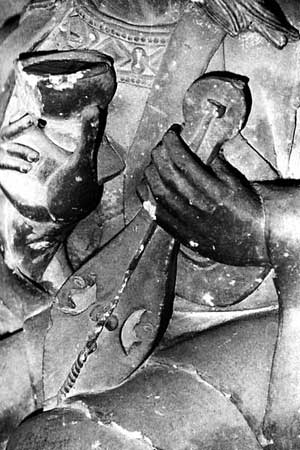
Plate 9 : Pear-shaped giga provided with a single string
on the early tympanum of the west gate at Moissac (1100-1115).
[1] For a more detailed description of the oval fiddle see : Francisco Luengo, “Instruments à archet dans le nord-ouest de la Péninsule Ibérique, XIIe et XIIIe siècles” and John Wright, “L’instrument caché. Réflexions sur la problématique des répliques d’instruments à cordes ...”, in : Christian Rault (edenda curavit), Instruments à cordes du Moyen- Age, Fondation Royaumont, éd. Créaphis, Bar le Duc, 1999, pp.115-131 and 133-166. See also: Christian Rault, “Iconographie et reconstitution, quelques expériences récentes et une illustration : la vièle ovale,” in: “Les cahiers de musique médiévale n°2” , Centre de musique médiévale de Paris, 1997, pp. 28-41, and Christian Rault, “Les modifications structurelles radicales des instruments à cordes au XVIème siècle” in the review of the Occitan conservatoire Pastel, n° 21, juillet-août-septembre 1994, pp. 30-36.
[2] The term “oval fiddle”, applies to the instruments on the Gate of the Glory at Santiago and to the majority of subsequent fiddles. Previously, fiddles with the same structural characteristics and with the same, and very particular, string arrangement could be pear-shaped. This is why the broader term of medieval fiddle is employed.
[3] Sometimes the giga adopts the pegbox of the medieval fiddle (Angers and south door of Chartres Cathedrals)
[4] Johannes de Tinctoris attests that this arrangement was sometimes reduced to three single strings without altering the definition of the instrument: “sive tres ei sint chorde simplices ut in pluribus :per geminiam diapentam: sive quinque sic et per unisonos temperate: inequaliter”, cf. K. Weinmann, Ein uberkannter Traktat des Johannes de Tinctoris, Riemann-Festschrift, Leipzig, 1909, p. 41.
[5] Francisco Luengo recounts these remarks in Instruments à cordes du Moyen-Age... id. 1999, p. 124.
[6] For more information on the organistrum, see: Christian Rault, L’organistrum ou les origines de la vièle à roue, Aux amateurs de livres, Paris, 1985, 188p.
[7] The first occurrence of the term organistrum is to be found in the Wolfenbütel manuscript which dates back to the year 1100. Herzog August Bibliothek. Cod. Guelf. 334, Gud. lat. 110v° et 111r°, from the Benedictine abbey of Saint Ulrich-et-Afra of Augsburg.
[8] The first picture of a "figure of eight shaped fiddle" is from 1109 and comes from the Abbey of Citeaux. It is pictured in the hands of one of King David’s musicians in the St. Etienne Harding Bible, Dijon Public Library, Ms. 14, vol. III, f° 13v°.
[9] Capital at Boscherville, Santiago de Compostela, Orense, N.D. de Paris, Soria, Toro, illuminated letter B of the psalter Hunter 229 in the Glasgow University Library, Ms. 59, f°38v, Antiquarian Society of London.
[10] In North Africa, this left-handed fingering technique does not involve the use of the fingerboard . It was still popular in Central Europe at the beginning of the twentieth century for all the instruments related to the ancient lyre : crowd, kantelaharpe, talharpa ...
[11] See following footnote.
[12] Instruments of the crwth family cited in footnote 10 as well as those related to the Grecian lyre: Bulgarian godulka , Yugoslavian gusla...
[13] Original book of extracts by Scheftlarn, Bayrische Staatbibliothek, Munich, Clm 17142, op. cit. Werner Bachmann, The origins of bowing, O.U.P. , Oxford, 1969, p. 83.
[14] For more details on tuning the organistrum, see Christian Rault, id. L’organistrum... 1985, pp. 120-125
[15] Smits van Waesberghe, “Organistrum, symphonia, drehleier”, in: H.H. Eggebrecht, Handwörterbuch des Musikalischen Terminologie, Tome II, Steiner, Wiesbaden, 1972, pp.4-5.
[16] See footnote 9.
[17] Unless the giga had silk strings in certain cases, as a late German text suggests (16th century), see note 22.
[18] This is not the case for the Greek and Indian technique which uses the back of the nail. When associated with fine, taut strings this technique allows greater precision and subtle, refined ornaments.
[19] The nature and tension of the strings plays an essential role here and the expressive possibilities of the thick gut strings of the Andalusian rabâb or the horesehair strings of the Egyptian rabâb and the sousi kamandjé, bear no comparison to the fine silk strings of the Chinese spiked fiddle.
[20] Walter Salmen “ La tenue de la harpe au Moyen-Age”, in : Christian Rault (edenda curavit), Instruments à cordes du Moyen-Age, 1999, p. 92.
[21] Mary Remnant, English bowed instruments from anglo-saxon to tudor times, Clarendon Press, Oxford, 1986, p. 31.
[22] Op. cit, W. Bachmann, id. 1969, p.122.
[23] Op. cit. P. Bec, , Vièle ou viole, variations philologiques et musicales autour des instruments à archet du Moyen Age, Klincksieck, 1992, p. 371.
[24] Giga est instrumentum musicum de quo dicitur organicos imitata modos, in: J. Pulver, A Dictionary of old English Music, Musical Instruments, London, 1923, p. 117.
[25] Christopher Page, Voices and instruments of the Middle Ages, J.M. Dent & sons Ltd., London Melbourne, 1987, p. 241.
[26] Mary Remnant, id., 1986, pp. 31 and 98-99.
[27] Christian Rault, “Du rabâb au rebec” in catalogue to the exhibition, Instruments de musique du Maroc et d’al-Andalus, Catherine Homo-Lechner et Christian Rault (edenda curavit), Fondation Royaumont / C.E.R.I.M.M., Royaumont, 1999, pp. 72-82.
[28]It is important to distinguish between the two instruments which have the same generic name in Arabic, that is rabâb, but which are entirely separate entities. The former, also called kamandjé is the primitive spiked fiddle, the latter is the arabo-Andalusian round-backed rabâb which inspired the rebec. While the first instrument appeared very early on (as shown by al-Farabi as early as the beginning of the 10th century), there is no documentary evidence al-Andalus of the latter before the middle of the 13th century.
[29] Pierre Bec, id., 1992, p. 225-26.
[30] Five strings, two paired and one single, (see note 5).
[31] M. Remnant, id. 1986, pp. 83-84.
[32] We will rule out the rote which is mentioned in the 6th century by Venance Fortunat in the guise of chrotta britanna . The term made its way into vulgarised Latin languages in the 9th century and musicologists agree on the fact that it inherited a lyre-form from Greco-roman antiquity, an opinion we share. The word was later to become crowd (English) and crwth (celtic) and was probably also used in the form of rotte (German), to refer to the “ harp-psaltery” and more generally to open-stringed instruments .
[33] Ms. 337, from St. Amand, Michel Huglo, “Cithara-braci”, in Bulletin d’archéologie musicale n°3, sept. 1984, p.8.
[34] Catherine Homo-Lechner, Les cordophones dans l’Occident médiéval du VIème au XIIè siècle, Doctoral thesis in Art History, Paris/Sorbonne, 1991, p.85.